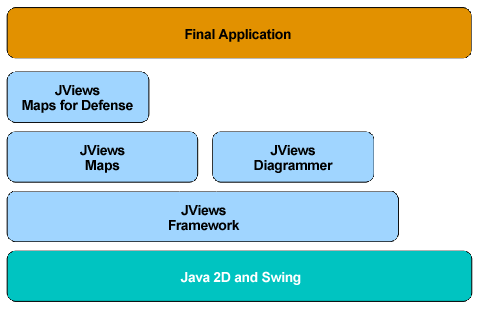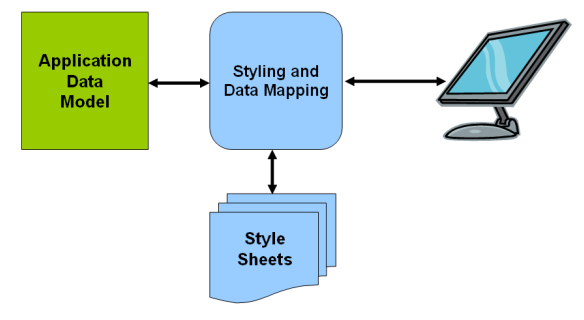SDKs
Rogue Wave JViews Maps for Defense includes five different component libraries.
The topmost layer represents the Java code of the application, which can interact with any or all of the SDKs provided, or bypass them when required and directly call the Java2D or Swing APIs.
For example, the Rogue Wave JViews Diagrammer SDK is needed when you display interactive objects on top of your maps (the symbols), whereas the JViews Maps for Defense SDK handles the map background manipulations.
The modules in this architecture and the services they offer are shown below:
Rogue Wave JViews Maps for Defense architecture diagram (from a services perspective)
Starting with the bottom layer, all Rogue Wave JViews libraries are built on top of the Java2D and Swing libraries, with no platform-specific code. This means that applications developed with Rogue Wave JViews run on any platform that supports Java.
On top of this low-level layer is the JViews Framework layer, which includes among others, efficient data structures, prebuilt user interaction services, and a printing facility. JViews Framework is not sold by Rogue Wave as a separate product; it serves as a core component of each of the products in the Rogue Wave JViews product line.
Above JViews Framework is JViews Maps, which provides a wide range of map manipulation and display services. It is built on the data structures and I/O facilities of JViews Framework.
At the same level, there is Rogue Wave JViews Diagrammer, which provides a wide variety of displays consisting of custom graphic objects that are data-aware. This means that the graphic objects in the display can change their appearance as the underlying data model changes. For example, a graphic object that represents a vehicle can have its color change if its status field changes.
Rogue Wave JViews Diagrammer uses a Model-View-Controller (MVC) architecture that will be very familiar to Java programmers used to the Swing structure. Its purpose is to separate the data model from the views and connect the two with a rule-based style manager that controls the look of the objects based on the data values, see below:
Data model architecture
JViews Diagrammer calls this mechanism Styling and Data Mapping (SDM). It is used by Rogue Wave JViews Maps for Defense to store and manipulate any interactive object that appears on top of a map.
Thus, Rogue Wave JViews Maps for Defense uses two distinct data structures:

One for storing the map data that is relatively static (such as definitions for roads and boundaries).

SDM for storing information about the custom objects of an application.
Rogue Wave JViews Maps for Defense is built on top of the layer that contains JViews Maps and JViews Diagrammer. The specific contribution of JViews Maps for Defense is to provide the terrain analysis and APP-6a symbology features. A set of map formats specifically for military use are also provided.
The final application is Java code that performs a mix of Swing, Java2D, and JViews SDK calls. The application code can be as little as a few lines that simply load the outputs of files created by the Rogue Wave JViews Maps for Defense application, or a sophisticated analysis tool with dynamic map and data feeds. In both cases, the reuse of ideas and code from the Map Builder application is encouraged.
Copyright © 2018, Rogue Wave Software, Inc. All Rights Reserved.

